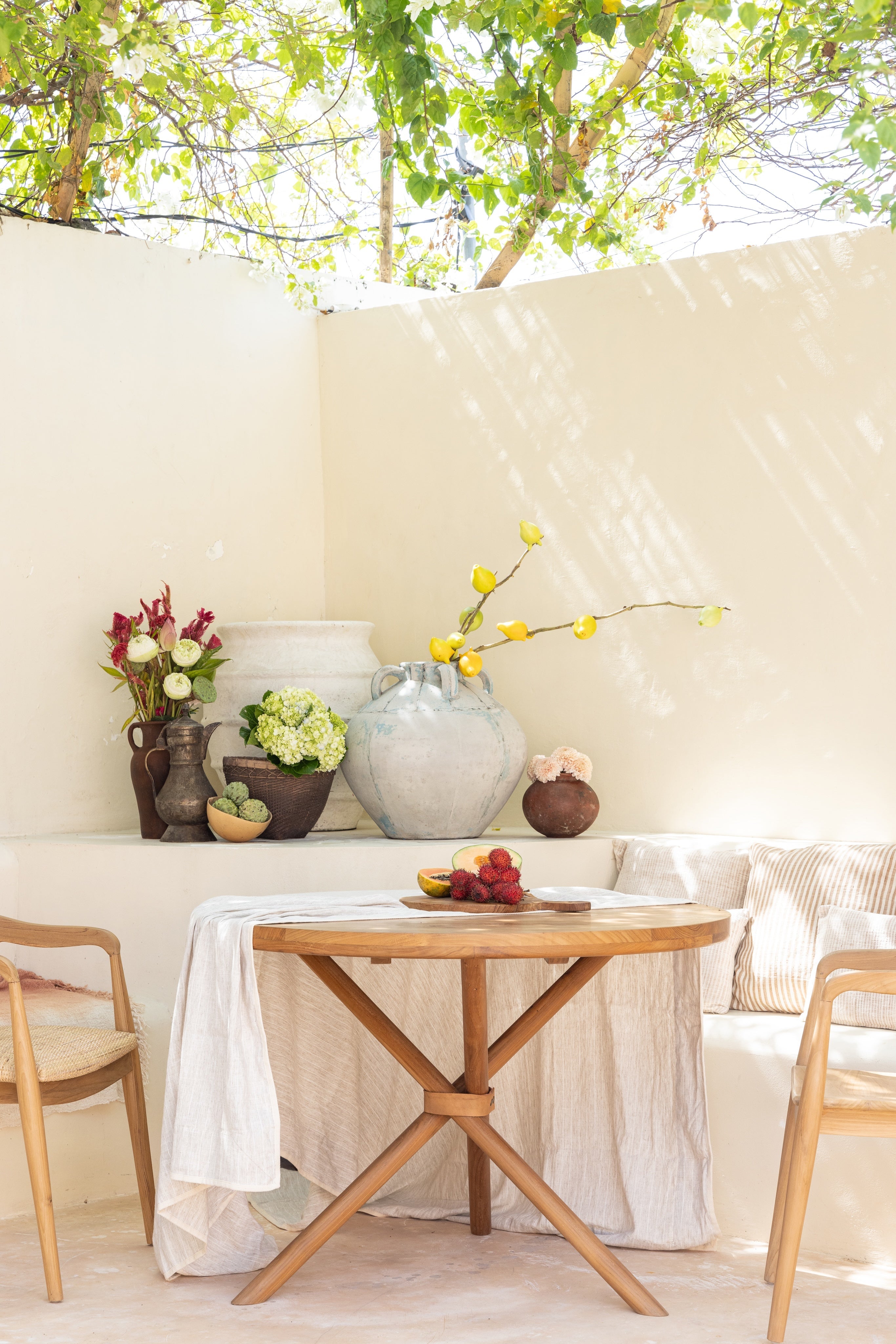Natural Interiors: How to Layer Organic Decor for a Calm and Textured Space

Step into a room that feels like it was built to breathe. The surfaces are raw, the tones are warm, and the feeling is unmistakably peaceful. This is what happens when you begin to layer natural elements. At balè, we believe interiors should do more than look beautiful. They should feel like a gentle exhale.
Creating that feeling starts with the materials you choose and the way you combine them to bring a space to life. You don’t need to start from scratch. With a few considered layers, you can shift your home into something deeper. Here’s how to bring that calm, textured energy into every corner of your home.
Begin with Honest Materials
The strongest spaces start with the most honest foundations. Teak, rattan, linen, stone, clay. These are materials that come from the earth and settle easily into it. If you’re redesigning a room, start here. Choose a solid wood dining table with weight and character. Let the natural tone of the timber set the palette for the room.
In a kitchen remodel, swap synthetic finishes for open timber shelving or a hand-formed ceramic sink. Even one element, like a teak bar stool beside the counter, can shift the feel of the space from sterile to soulful. These pieces don’t just fill a room, they change its rhythm.
Balance Texture and Stillness
Natural interiors are built on contrast. Not sharp or jarring contrast, but soft tension. You want rough beside smooth, heavy beside light, and open beside enclosed.
Imagine a rattan armchair placed next to a low stone coffee table. One invites the eye, the other grounds it. In the dining room, raw-edged wood pairs beautifully with soft, woven linens. Layer napkins over ceramic plates, let the folds fall without fuss. Imperfection is part of the charm.
If you’re experimenting with home aesthetic DIY projects, texture is your best tool. A clay lamp on a smooth teak side table. A leather cushion on a structured wooden bench. These small pairings bring the room to life in ways you can feel more than see.
Invite in Pieces Made by Hand
Natural design doesn’t follow a formula. It follows feeling. The easiest way to infuse that into your space is by choosing handmade objects that carry the warmth of the person who made them.
A rattan pendant that casts soft shadows. A side table carved by hand with visible grain. A woven tray that’s never quite perfectly round. These are the pieces that remind you a home doesn’t need to be polished to feel complete.
In an outdoor kitchen, where materials matter even more, these handcrafted layers shine. Choose bar stools made with real timber that age gracefully with the weather. Use ceramics that hold a little warmth in your hands. Even in a covered outdoor space, small details like this turn the area into an extension of your home rather than something separate.
Let the Palette Breathe
Color is powerful, but restraint is where calm lives. Think of tones you’d find walking through the woods or standing barefoot on the beach. Clay, sand, olive, charcoal, cream, earth. They don’t compete. They drift softly into each other.
Natural interiors avoid anything too crisp. Instead of painted finishes, opt for oiled woods that darken with time. Instead of bold fabrics, lean into texture for visual interest. Let the pattern come from a woven rattan basket or a linen curtain that sways with the breeze.
Your living room decor will thank you. Start with one anchoring piece, like a teak coffee table, then build slowly. A low jute rug underfoot. A stack of books with natural covers. A quiet scent in the air. Nothing flashy. Everything thoughtful.
Layer Slowly, Live In Between
Rooms feel most alive when they’ve been built over time. Matching sets flatten the energy of a space. Instead, let it grow. One item at a time. Start with a piece you love and build around it.
Maybe that’s a sculptural lounge chair or a side table that makes you pause. Use it as a reference point, then slowly introduce supporting pieces that add depth without stealing focus.
Layering doesn’t just mean stacking textures. It means leaving space for pauses. An empty shelf. A bare wall. A smooth bowl on a rough bench. These moments give your eyes room to rest and your space room to breathe.
Style with Purpose
Every element in a natural interior should serve a purpose. That doesn’t mean everything needs to be utilitarian. It just means nothing should feel like filler.
Choose furniture that holds its own. A bar stool that stands up to daily use but still looks beautiful from every angle. A dining table with proportions that invite conversation. A teak bench that can move from your entryway to the edge of your bed without missing a beat.
If you’re drawn to minimalist design, this approach allows you to keep your home feeling open without feeling cold. It also means less clutter and more meaning.
Let Nature In
This step is quiet but essential. Let the outdoors influence the way your home moves. Place your furniture to follow the light. Use large, open windows to frame greenery. Let natural air flow through the rooms.
Bring in living plants, dried branches, shells, or river stones, not as decoration, but as presence. These elements remind you to slow down, to notice, to stay connected. They are not trends. They are tools for grounding.
In warm climates, your outdoor kitchen or covered porch can become a second living room. Treat it with the same intention. Use natural textiles. Let teak stools or chairs invite gathering. These areas deserve the same attention to detail as your interiors.
Time to Style Your Own Organic Decor
Layering organic decor is about more than how a space looks. It’s about how it feels. The way the surfaces shift under your hand. The way the light falls across raw wood. The way your body relaxes without even realizing.
There’s no perfect formula. No checklist. Just a willingness to slow down and make room for what matters. At balè, that means craftsmanship, story, texture, and timeless materials that live well and age beautifully.
Begin wherever you are. One item. One layer. Let the rest unfold in its own time.




